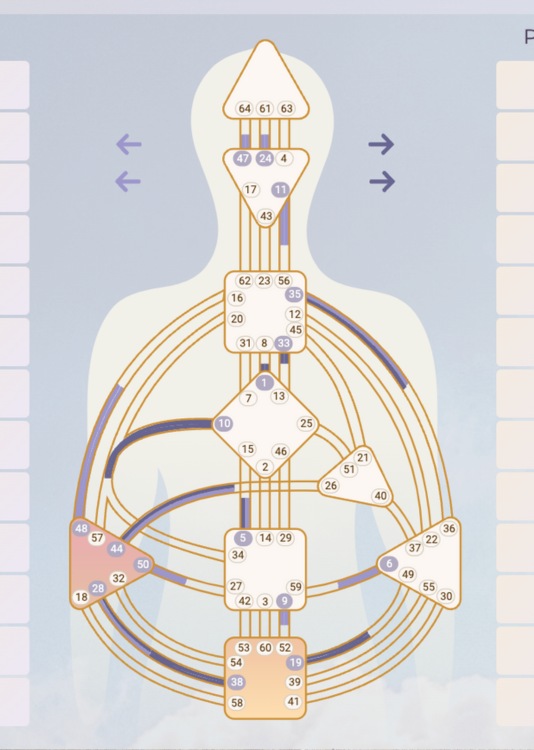Human Design can feel overwhelming when you first encounter it. I hope that by giving you the basics of this amazing system, I can help simplify your journey into it and find more clarity and insight into your life.
Human Design is a comprehensive system that dives deep into your energetic blueprint, offering profound insights into your true nature and life purpose.
In a world where personal development tools are everywhere, Human Design stands out as a unique guide, helping you align with your authentic self and make decisions with less resistance. Whether you’re navigating big decisions or seeking to understand your consistent energy patterns, your unique Human Design chart serves as a map to your highest potential.
The Human Design system was founded by Ra Uru Hu, born Robert Allan Krakower, in 1987. He introduced this groundbreaking system after experiencing a mystical encounter, leading to the creation of a unique synthesis of ancient wisdom and modern science.
Human Design integrates elements from quantum physics, Western astrology, the chakra system, and the Tree of Life to form a holistic approach to understanding our genetic makeup and energetic body. This system reveals the science of differentiation, showing us how each person is designed to operate in their own unique way, with a specific life theme and purpose.
Through the lens of Human Design, you can embark on a journey of self-discovery, unlocking your true self and tapping into your innate gifts.
Jump to the section you want to explore:
What is the Human Design System
Core Components of the Human Design System
What is the Human Design Chart
What are Centers in a Human Design Chart
Different Energy Types
What is the Science Behind Human Design?
How to Use Human Design for Personal Growth
What is the Human Design System?
The Human Design system is a powerful tool that offers deep insights into your genetic makeup and energetic blueprint, allowing you to understand how you are uniquely wired. Unlike other systems, Human Design combines modern science with ancient wisdom to provide a clear map of your true nature.
By decoding the information in your Human Design chart, you can gain clarity on your natural strengths, challenges, and the most aligned way to navigate your life. This system helps you recognize patterns in your life force energy, guiding you to live in a way that resonates with your authentic self.
Core Components of the Human Design System
At the heart of the Human Design system are several key elements that work together to paint a complete picture of who you are:
Human Design Chart
Your Human Design chart, also known as a BodyGraph, is a visual representation of your energetic blueprint. It is created using your exact time and date of birth and maps out your unique configuration of energy centers and channels.

Energy Centers
These are similar to the chakras in the chakra system and represent different aspects of your being, such as the Sacral center for life force and creative energy, or the Spleen center for intuition and survival instincts.
The condition of these centers—whether they are defined or undefined—affects how you process energy and interact with the world around you.
Human Design Types
There are five main types of Human Design: Manifestors, Generators, Manifesting Generators, Projectors, and Reflectors. Each type has its own unique way of operating and interacting with others. Understanding your type helps you align with your natural strategy and authority, enabling you to make decisions that lead to greater ease and fulfillment in life.
What is The Human Design Chart?
The Human Design chart, often referred to as a BodyGraph, is a visual representation of your unique energetic blueprint. It is created using your exact time of birth, date of birth, and location, capturing the precise positioning of the planets at the moment you were born.

This is my human design design chart for reference.
I am a Projector with a 1/3 Profile, Splenic Authority.
Are you a Projector? Explore A Projector’s Guide to Deconditioning for Success & Abundance
Your unique chart is a map that reveals the different energy centers within your body, along with channels and gates that influence how you interact with the world.
Unlike traditional personality tests, the Human Design chart offers a personalized guide to understanding how your energy operates and how you are designed to make decisions that are in alignment with your true nature. Your Human Design chart is unique to you, it’s like a fingerprint.
What are the Centers in a Human Design Chart?
In the Human Design system, our energy is mapped out across nine distinct centers, each playing a crucial role in how we experience and interact with the world. These centers, akin to the chakras in Eastern traditions, represent different facets of our being—from the way we think and feel, to how we communicate, make decisions, and manage stress.
Understanding the function of each center in your Human Design chart provides valuable insights into your strengths, challenges, and unique way of navigating life. Let’s explore these centers and discover what they reveal about your energetic blueprint.
1. Head Center
- Understanding: Inspiration, ideas, and questions.
- Role: The Head center is the source of mental pressure, driving us to seek answers and clarity. It governs how we process inspiration and external influences, often prompting us to ask big questions about life.
2. Ajna Center
- Understanding: Conceptualization, analysis, and belief systems.
- Role: The Ajna center is responsible for processing information, forming concepts, and developing opinions. It helps us understand how we mentally interpret and analyze the world, shaping our perspectives and beliefs.
3. Throat Center
- Understanding: Communication, manifestation, and expression.
- Role: The Throat center is the hub of communication and action. It governs how we express ourselves, manifest ideas into reality, and interact with others through speech and actions.
4. G Center
- Understanding: Identity, direction, and love.
- Role: The G center, also known as the self-center, is the core of our identity and sense of direction in life. It helps us understand who we are, where we’re going, and how we connect with love and purpose.
5. Heart (Ego) Center
- Understanding: Willpower, self-esteem, and material resources.
- Role: The Heart center is associated with ego, willpower, and the drive to prove oneself. It governs our sense of self-worth, determination, and how we manage resources like money and material possessions.
6. Sacral Center
- Understanding: Life force energy, work, and response.
- Role: The Sacral center is the source of sustainable energy for work and creativity. It helps us understand how we generate and use energy in our daily lives, guiding us in responding to opportunities and challenges.
7. Solar Plexus Center
- Understanding: Emotions, desires, and emotional authority.
- Role: The Solar Plexus center governs our emotional life, influencing how we experience and process feelings. It helps us understand our desires, emotional waves, and how to make decisions when clarity is needed.
8. Spleen Center
- Understanding: Intuition, survival, and health.
- Role: The Spleen center is linked to instinctual awareness and the body’s immune system. It governs our sense of timing, well-being, and how we respond to immediate threats or opportunities with intuition.
9. Root Center
- Understanding: Stress, drive, and pressure to act.
- Role: The Root center is the source of pressure that drives us to take action and achieve goals. It helps us understand how we deal with stress and manage the pressures of life, influencing our motivation and endurance.
10. Sacral Center
- Understanding: Life force energy, work, and response.
- Role: The Sacral center is the source of sustainable energy for work and creativity. It helps us understand how we generate and use energy in our daily lives, guiding us in responding to opportunities and challenges.
11. Root Center
- Understanding: Stress, drive, and pressure to act.
- Role: The Root center is the source of pressure that drives us to take action and achieve goals. It helps us understand how we deal with stress and manage the pressures of life, influencing our motivation and endurance.
Different Energy Types in Human Design
In the Human Design system, individuals are categorized into five distinct energy types, each with its own unique way of interacting with the world. These types are Manifestors, Generators, Manifesting Generators, Projectors, and Reflectors.
Manifestors
Manifestors are the initiators, designed to bring new ideas into the world with their powerful energy to start projects and influence others.
Generators and Manifesting Generators
Generators and Manifesting Generators are the builders, possessing sustainable life force energy primarily driven by the Sacral center. Generators are masters of response, thriving when they are doing work that excites them. Manifesting Generators, a hybrid type, combine the initiation ability of Manifestors with the sustainable energy of Generators, allowing them to move quickly and efficiently.

Projectors
Projectors are guides and leaders, designed to understand and direct the energy of others.
They do not generate their own sustainable energy and must be mindful of how they use their energy, often relying on the recognition and invitation from others to share their wisdom.
Learn more about embracing your energy type as a projector.
Reflectors
Reflectors are mirrors of their environment, reflecting the energies of those around them. They are highly sensitive and require a full lunar cycle (about 28 days) to make major decisions, as they sample all the different energies over time.
What is the Science Behind Human Design?
At the heart of the Human Design system is the integration of quantum mechanics and quantum physics, offering a profound understanding of the life force and the energetic body. Quantum mechanics, the branch of physics that explores the behavior of energy and matter on the smallest scales, provides the scientific foundation for how our energy operates beyond the physical realm.
In Human Design, this translates into a deeper awareness of how we are not just physical beings but also energetic ones, with each person’s energetic blueprint being influenced by subtle forces that quantum physics helps to explain.
This understanding allows us to see that our interactions with the world and others are not merely physical but also energetic exchanges. Our thoughts, emotions, and decisions are all forms of energy, resonating with the life force that animates us.
By applying principles from quantum mechanics, Human Design shows us how our energetic body is shaped by the unique configuration of our energy centers, which guide how we express our life force in the world.
Science of Differentiation
Human Design also delves into the science of differentiation, offering a unique perspective on how each individual is genetically and energetically distinct. Unlike traditional systems that often categorize people into broad types, Human Design acknowledges that every person has a unique combination of traits, talents, and potentials that are encoded in their genetic makeup.
This differentiation is not just about physical attributes but also about how we are designed to interact with the world and fulfill our life purpose.

Revealing your Innate Gifts
The system reveals how our innate gifts are linked to specific aspects of our design, such as the channels and gates in our Human Design chart, which correspond to our energy centers.
These gifts are not random but are tied to our specific life theme, guiding us toward the path we are meant to follow.By understanding the science of differentiation, we can embrace our true nature and live in alignment with our highest potential, making decisions that honor our unique design.
Human Design’s approach to differentiation helps us appreciate the incredible diversity of human experiences and expressions. It teaches us that by understanding our unique energetic blueprint, we can better navigate life, embrace our individuality, and contribute our distinctive gifts to the world.
How to use Human Design for Personal Growth
Embarking on your Human Design journey is a powerful step toward uncovering your true self and embracing your authentic self. This journey is not just about understanding your energetic blueprint but about living in alignment with it.
By exploring your Human Design, you gain insights into your natural strengths, challenges, and unique way of navigating the world. It’s an invitation to step into your highest potential, making choices that are true to your nature and aligned with your life purpose.

Whether you’re seeking clarity in decision-making, deeper self-awareness, or a more fulfilling life, the Human Design journey offers a personalized roadmap to achieving less resistance and more flow in every aspect of your life.
Want a personalized reading from me?
I do Human Design readings as part of my work with The Collective Healers.
Get a personalized reading here.
As you begin your Human Design journey, here are some practical tips to help you integrate its wisdom into your daily life:
1. Start with Your Type: Begin by understanding your Human Design type—whether you are a Manifestor, Generator, Manifesting Generator, Projector, or Reflector. Knowing your type helps you understand your natural energy patterns and how you’re designed to interact with the world.
2. Follow Your Strategy: Each Human Design type has its own strategy for making decisions and taking action. For example, Generators and Manifesting Generators should focus on responding to opportunities rather than initiating them, while Projectors benefit from waiting for invitations before sharing their insights. Following your strategy reduces resistance and aligns you with the natural flow of life.
3. Understand Your Inner Authority: Your inner authority is your unique decision-making mechanism, whether it’s emotional, sacral, or splenic. Learn to trust and listen to this inner guidance when making important decisions, as it reflects your true self’s desires and needs.
4. Pay Attention to Your Not-Self Theme: Each type has a not-self theme—such as frustration for Generators or bitterness for Projectors—that signals when you’re out of alignment with your design. Recognizing these feelings can help you course-correct and return to a state of flow and ease.
5. Experiment and Reflect: Human Design is an experiential system, meaning the best way to
understand it is through personal experimentation. Try applying the principles in your daily life and observe how they affect your experiences and relationships. Reflect on what works for you and what doesn’t, adjusting your approach as needed.
6. Explore Your Energy Centers: Dive deeper into your chart by exploring your defined and undefined energy centers. Understanding which centers are consistently active and which are more open to external influences can help you manage your energy and avoid unnecessary stress.
7. Seek Guidance: As you navigate your Human Design journey, consider seeking guidance from a Human Design practitioner (Like me! You can find more of my Human Design work here.) or using resources like books, courses, or online communities. These can provide additional insights and support as you learn more about your unique design.
By integrating these practical tips into your life, you’ll find that the Human Design system not only helps you better understand yourself but also empowers you to live with greater purpose, ease, and fulfillment. Your journey is a lifelong process of self-discovery and growth, leading you ever closer to your authentic self.














